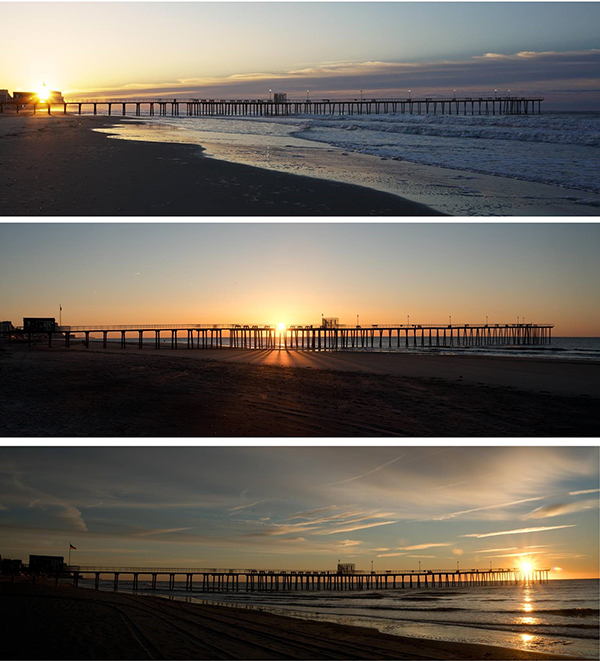Jun 20, 2019
By Guest Blogger Steve Jasiecki of Sustainable Downbeach
Friday, June 21, is the summer solstice, the first day of summer. This marks the longest day of the year and when the sun reaches its highest position in the sky.
On this day, the sun will reach its northern most rising position and its northern most setting position. From then on till December 21, the days will start to get shorter until we reach the winter solstice and the cycle starts over again.

Using the Ventnor Fishing Pier as a measuring stick, you can see how the sun rises in different locations throughout the year. The top image is the summer solstice in June, the middle image is the equinox in September and March, and the bottom image is the winter solstice in December.
We all know that during the summer, the sun travels higher in the sky bringing warmer months and longer days, while during winter, the sun travels across the sky at a lower angle giving us colder months and shorter days. What may not be as noticeable is that where the sun rises and sets changes slightly every day. As we approach summer, the sun rises a little more to the north each day until the solstice. Once we reach the summer solstice, the sun rises at the same spot for several days, then the sun reverses it’s direction and rises a little more south each day until we reach the winter solstice. At that point, the sun will rise in the same position for a few days, reverse its direction and then start to rise a little more north each day until the summer solstice. This movement is also true for where the sun sets.
The time when the sun stops its northern or southern migration was given the name “Solstice” which literally means, “Sun stands still”. At the mid point of Earth’s journey between the solstices, March for spring and September for fall, the Earth experiences an equal amount of daylight and nighttime hours. This period is called the “Equinox” meaning “Equal night”.
Of course the sun isn’t doing the moving. The change of position is due to the Earth’s 23.4-degree tilt. As the Earth revolves around the sun, the angle of the Earth changes our position in relation to where we see the sun as it rises and sets.
If the Earth’s poles were perpendicular to the sun, meaning no tilt, we wouldn’t experience any change in the seasons and the sun would rise and set at the same spot everyday.
The summer will continue to get warmer as it takes awhile for the oceans and landmasses to heat up as there is a time lag due to the Earth’s absorption of the sun’s energy.
On the day of the summer solstice the sun will rise at 5:30 a.m. at 58 degrees East-Northeast. It will set at 8:26 p.m. at 302 degrees West-Northwest. We will have 14 hours and 56 minutes of daylight. Solar noon, when the sun is highest in the sky, will be at 12:58 p.m. (daylight savings time) at an angle of 74 degrees. The Earth will be 94 and a half million miles from the sun.
Happy Solstice and enjoy the summer.